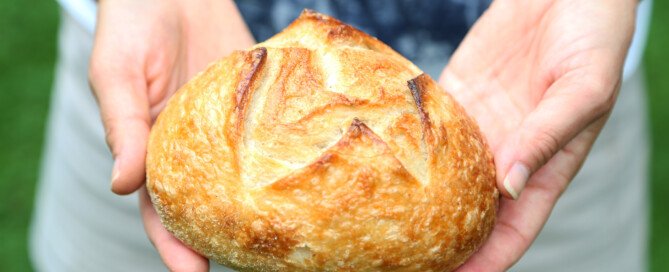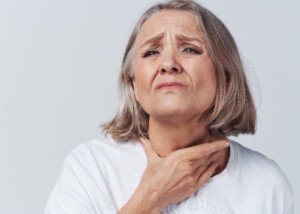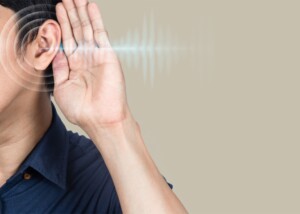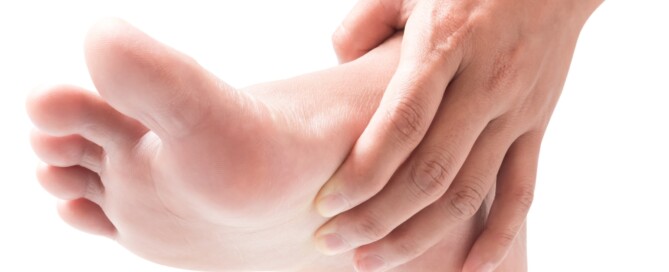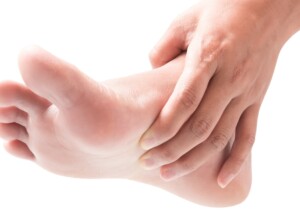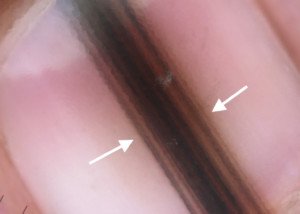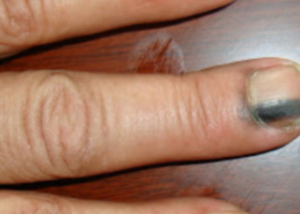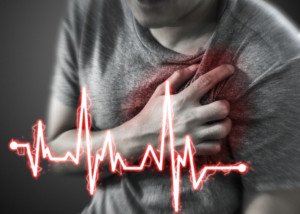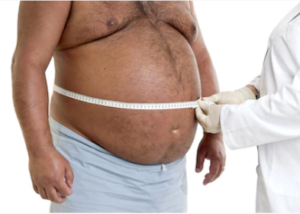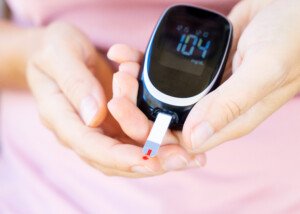Can Muscle Twitching Be Caused By Gluten Intolerance?

Chronic muscle twitching (fasciculations) at various locations of the body can actually be caused by a gluten intolerance, and the effective treatment could be an elimination of gluten. (more…)
Botox: Effective Treatment for Benign Fasciculation Syndrome

The botulinum toxin type A, aka Botox, has been shown to be effective at treating benign fasciculation syndrome (BFS). (more…)
22 Diseases that Mimic ALS Symptoms, Can Lead to Misdiagnosis

There are far more conditions that mimic ALS than you can imagine: at least 22.
“Potentially curative treatments exist for certain ALS mimic syndromes,” states a report in the Iranian Journal of Neurology (April 2016), “but delay in starting these therapies may have an unfavorable effect on outcome.”
ALS Mimic Syndrome
ALS mimic syndrome refers to a group of medical conditions whose clinical presentation resembles those of ALS in the latter’s early stages.
The IJN points out that there have been only a few studies published regarding ALS mimic syndrome.
According to population based studies, nearly 10 percent of people diagnosed with ALS have actually had a different medical condition.
Diseases that Mimic ALS and Their ALS-Like Symptoms
• Adrenomyeloneuropathy – lower leg stiffness and partial paralysis
• Adult polyglucosan body disease – progressive muscle weakness and stiffness
• Allgrove AAA syndrome – atrophy, muscle weakness, movement problems
• B12 deficiency – muscle weakness, problems with walking
• Benign monomelic amyotrophy – atrophy and weakness of one limb; fasciculations; possibly reduced reflexes
• Celiac disease – atrophy, weakness, fasciculations
• Creutzfeldt-Jakob disease – atrophy, fasciculations
• Inclusion body myositis – asymmetric weakness, difficulty swallowing
• Isaac’s disease – atrophy, weakness, fasciculations, diminished reflexes
• Isolated neck extensor myopathy – weak neck muscles
• Kennedy’s disease – atrophy and weakness of facial, bulbar and limb girdle muscles; tremor; fasciculations near the mouth
• Lyme disease – weakness, fasciculations
• Mitochondrial disorder – atrophy, weakness, fasciculations
• Multifocal motor neuropathy with conduction block – focal weakness; fasciculations
• Multiple sclerosis – limb weakness, unsteady gait, slurred speech
• Myasthenia gravis – muscle weakness, trouble chewing and swallowing
• Oculopharyngeal muscular dystrophy – bulbar weakness
• Overactive thyroid – weakness, fasciculations
• Paraneoplastic encephalomyelitis – unsteady gait leading to paralysis; slurred speech; trouble swallowing
• Post-polio syndrome – atrophy, weakness, problems swallowing
• Syringomyelia – atrophy and weakness
• Transthyretin familial amyloid neuropathy – tongue atrophy and fasciculations
Considerations
All of the aforementioned conditions present with at least one symptom that is seen with ALS.
Some of the conditions eventually present with symptoms totally unrelated to neuromuscular function, and in other cases may present with those symptoms right from the get-go.
So nothing’s engraved in stone here; variability is high.
The mimicking nature of these disorders is apparent mostly in their early stages before the more non-relevant symptoms start popping up such as bowel and bladder dysfunction, rapid heart rate, vision problems and cognitive impairment, to name a few.
As mentioned, there’s much variation involved. For instance, in oculopharyngeal muscular dystrophy, the eyelids are usually affected – but in ALS they are not.
But there are cases of oculopharyngeal muscular dystrophy in which eyelid involvement is minimal, and most of the weakness is seen in the bulbar region, making this disease a potential mimicker of bulbar-onset ALS.
Another consideration is that the more progressed the above disorders become, the less they resemble ALS, especially ALS in its early stages.
The longer the time lapse, the more apparent the differences become in symptoms and clinical presentation.
- For example, some of the diseases have a very slow progression.
- Another example is benign monomelic amyotrophy: The pathology remains in just one limb.
Benign fasciculation syndrome mimics ALS more so in the petrified mind of the patient rather than to the neurologist.
The Iranian Journal of Neurology goes on to point out that fasciculations with motor neuron disease are asymptomatic and that the patient is unaware of them until the physician detects them.
“They are diffuse and rarely are the presenting symptom,” states the paper.
“Muscle fasciculation without weakness should be considered a benign phenomenon,” continues the Journal, “although follow-up (sometimes 6 months or more), might be required to confirm benign nature of that.”
 Lorra Garrick has been covering medical, fitness and cybersecurity topics for many years, having written thousands of articles for print magazines and websites, including as a ghostwriter. She’s also a former ACE-certified personal trainer.
Lorra Garrick has been covering medical, fitness and cybersecurity topics for many years, having written thousands of articles for print magazines and websites, including as a ghostwriter. She’s also a former ACE-certified personal trainer.
.
Sources
ncbi.nlm.nih.gov/pmc/articles/PMC4912674/ ghr.nlm.nih.gov/condition/adult-polyglucosan-body-disease
rarediseases.info.nih.gov/diseases/457/triple-a-syndrome
webmd.com/diet/vitamin-b12-deficiency-symptoms-causes#2-6
jnnp.bmj.com/content/75/suppl_2/ii43
rarediseases.info.nih.gov/diseases/6793/isaacs-syndrome
tandfonline.com/doi/abs/10.3109/21678421.2014.980614
mayoclinic.org/diseases-conditions/post-polio-syndrome/symptoms-causes/dxc-20314513
ncbi.nlm.nih.gov/pmc/articles/PMC4746052/
pdfs.semanticscholar.org/7f32/c57551bfb64dc687c96ee1ca0302cac7541c.pdf
jmedicalcasereports.biomedcentral.com/articles/10.1186/1752-1947-7-218
mayoclinic.org/diseases-conditions/multiple-sclerosis/symptoms-causes/dxc-20131884
lymedisease.org/lyme-basics/lyme-disease/about-lyme/
mayoclinic.org/diseases-conditions/myasthenia-gravis/symptoms-causes/dxc-20200262
Throwing up in the Mouth While Asleep: Benign Cause, Solutions

Throwing up in the mouth while asleep or overnight is not a literal vomiting up of contents from the stomach in the way you would after eating bad meat or from a bad reaction to a drug. (more…)
Why You Have Constipation after Gallbladder Surgery

Constipation after removal of the gallbladder is actually common, and is not an indication that something went wrong during the surgery.
For the procedure, an anesthetic is required to paralyze the bowel so that the gallbladder can be removed.
The paralysis of the bowel (sounds worse than it actually is) is what may cause constipation following gallbladder removal.
This side effect may last a week or more.
An indirect cause of constipation following gallbladder removal “is a side effect of anesthesia or pain medications one takes after an operation,” says Dr. Baig.
If the patient is on narcotic painkillers such as Percocet or Vicodin, these may cause slower movement of the bowel — leading to constipation.
To combat backed-up stools or stools that are hard and difficult to void, the patient can take Colace, Metamucil or milk of magnesia.
In addition they can drink a juice that contains fiber — such as apple, prune, carrot, papaya and orange (with pulp — to improve bowel movements.
 Dr. Baig’s specialties include gastrointestinal cancers and liver disease, plus gallbladder, biliary tract and pancreatic disorders. He is an assistant clinical professor of medicine at the University of Medicine and Dentistry of NJ/Robert Wood Johnson Medical School.
Dr. Baig’s specialties include gastrointestinal cancers and liver disease, plus gallbladder, biliary tract and pancreatic disorders. He is an assistant clinical professor of medicine at the University of Medicine and Dentistry of NJ/Robert Wood Johnson Medical School.
 Lorra Garrick has been covering medical, fitness and cybersecurity topics for many years, having written thousands of articles for print magazines and websites, including as a ghostwriter. She’s also a former ACE-certified personal trainer.
Lorra Garrick has been covering medical, fitness and cybersecurity topics for many years, having written thousands of articles for print magazines and websites, including as a ghostwriter. She’s also a former ACE-certified personal trainer.
.
Top image: Shutterstock/nhungboon
Source: oregonsurgical.com/patient-info/instructions/gallbladder-removal/
Labyrinthitis vs. Brain Tumor Symptoms Comparison

Yes, there’s overlap with the symptoms of labyrinthitis and a brain tumor.
A brain tumor can cause so many more symptoms than what is typically described in pamphlets.
The vast array of symptoms that a brain tumor can cause is why there’s a symptom overlap into so many other conditions — including very benign.
This fact is frustrating to no end for people suffering from health anxiety and even those without HA.
The labyrinth is an inner ear structure that helps control one’s balance.
“Itis” means inflamed, so labyrinthitis is inflammation of this tiny structure.
Symptoms of Labyrinthitis (Vestibular Neuritis)
• Vertigo: sudden sensation of the room spinning or moving, which can make you unsteady on your feet. In severe cases walking is not possible.
• The vertigo can cause nausea and even vomiting.
• Hearing loss
• Tinnitus (“ringing” in the ears; persistent high frequency pitch, tone or hissing sound)
• Visual problems
• Difficulty with concentration
• Symptom onset is usually sudden—so much so that it’s common for alarmed sufferers to head to an ER or see their doctor the day of the sudden onset.
• After a flash-in-the-pan onset, the symptoms gradually dwindle, but the vertigo can become chronic on a lower scale if there was damage to the vestibular nerve—giving the patient a persistent feeling of feeling not very well.
Labyrinthitis normally resolves on its own, taking several weeks, when caused by a virus (most cases are). When bacteria is a cause, antibiotics can be prescribed.
Now here’s the first problem when it comes to comparing labyrinthitis or vestibular neuritis to a brain tumor:
There is no specific test for diagnosing labyrinthitis. Like the vexing condition of irritable bowel syndrome, the diagnosis is one of exclusion.
Thus, the physician must eliminate differentials or other possible causes of the symptoms.
This includes a brain tumor and even a stroke, side effects of drugs and anxiety.
This is nerve-racking for the patient, because initially, they may have figured that some in-office test would quickly confirm vestibular neuritis.
But they will walk out of the initial doctor’s visit without a confirmed diagnosis of this benign condition, and will still be fearful that “it” might be a brain tumor.
Brain Tumor Symptom Overlap with Labyinthitis
• Vertigo
• Trouble walking due to balance issues
• Nausea, vomiting
• Hearing loss
• Tinnitus (ringing in the ears)
• Visual problems
• Difficulty with concentration
Some Considerations
You’re going to like this: The type of brain tumor that classically causes hearing loss and tinnitus – and may also cause issues with vertigo and balance – is benign! It cannot metastasize.
It’s called acoustic neuroma and can be easily confirmed with an MRI. When it causes troublesome symptoms, there are several options for treatment including transcanal removal.
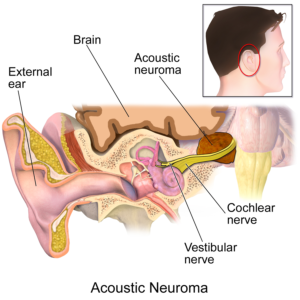
Source:: Blausen.com
A common feature of labyrinthitis that is not common in brain tumors is a sudden onset of marked symptoms.
A person with a malignant brain tumor isn’t going to be feeling great all along, then awaken next day with multiple severe symptoms.
Typically, symptoms from a brain tumor are gradual in progression, rather than suddenly you’re vomiting, can’t stay steady on your feet, have trouble seeing and can’t concentrate — all in one big bang.
As for the other overlapping symptoms, there’s no way around it: Brain tumors are notorious for causing nausea, vomiting and of course, visual disturbances and trouble concentrating.
A thorough workup is required to uncover the causes of these symptoms.
If the patient is experiencing all or even most of them, there’s an increased possibility that two conditions – unrelated to each other – are present.
 Lorra Garrick has been covering medical, fitness and cybersecurity topics for many years, having written thousands of articles for print magazines and websites, including as a ghostwriter. She’s also a former ACE-certified personal trainer.
Lorra Garrick has been covering medical, fitness and cybersecurity topics for many years, having written thousands of articles for print magazines and websites, including as a ghostwriter. She’s also a former ACE-certified personal trainer.
.
Top image: Shutterstock/aleks333
Sources
vestibular.org/labyrinthitis-and-vestibular-neuritis
webmd.com/brain/tc/labyrinthitis-topic-overview#1
mayoclinic.org/diseases-conditions/brain-tumor/symptoms-causes/dxc-20117134
Causes of Tar Black Vomit: It’s Old Blood, but Why?
If your vomit is tarry black, there’s more than one disease that can cause this, but the black itself is old blood.
Vomiting blood is always bad news and requires immediate medical attention. (more…)
Can Diabetes Cause Toenails to Turn Black?

If you have diabetes and are wondering if it’s related to an unsettling black patch on your toenail, you’ll want to head straight to a dermatologist first rather than to your diabetes doctor.
A slowly growing and increasing blackness or very dark area on a toenail may be a sign of melanoma skin cancer.
However, that is not the most likely cause. But what if you DO have diabetes?
An infection called paronychia affects the nail fold and can be chronic (longstanding) or acute (sudden).
This infection is not caused by diabetes, but is more common in diabetics.
When it’s chronic, the damage to the cuticle can lead to a distortion in the underlying nail tissues.
This will then cause a space that is vulnerable to infection.
One of the microbes that can infect this space is called Pseudomonas aeruginosa.
It is this microorganism that has the potential to give the nail an almost black (more likely a blue-black) color.
Another microbe, Fusarium, can cause a blackish patch in a toenail.
“Black toenails in a diabetic can happen when the foot has suffered a lack of oxygenated blood and necessary nutrients,” says J. Mark Anderson, MD, DABFM, of Executive Medicine of Texas and who is board certified in family medicine.
“This causes the toenail to die,” adds Dr. Anderson. “While red can be a sign of acute infection, brown and black are often a sign of permanent damage.”
Melanoma Can Turn a Toenail Black
“In rare cases, a black toenail, not related to the above listed conditions or to trauma (bruising), can be due to skin melanoma [below] that is actually under the nail bed,” says Dr. Anderson.
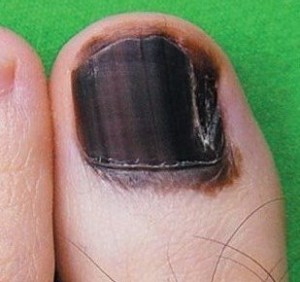
Typically, though, it’s not the entire nail, but can be most of it (below).
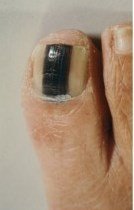
A hematoma (blood collection) can result in a “black” toenail.
Normally this is caused by either a blunt trauma (something falling on the foot) or prolonged sport or exercise activity such as hiking downhill in footwear that’s not as roomy as it should be.

Hematoma. Shutterstock/mortalpious
The darkness begins developing within a day or two of the trauma.
“Diabetics should always take time to look at their feet,” says Dr. Anderson.
“The color of feet, toes and even toenails can be a sign of uncontrolled diabetes which leads to organ damage and circulatory issues.
“Diabetes is not the only cause of black toenails. Liver, kidney and non-diabetic circulatory disease can also lead to this problem.
“Black toenails are not normal, and if you experience this issue you should seek medical attention, including a complete physical examination with bloodwork to uncover the underlying cause.”

Dr. Anderson is coauthor of the award-winning book, “Stay Young: 10 Proven Steps to Ultimate Health,” and host of the nationally syndicated Staying Young Show which goes to podcast as Staying Young Show 2.0.
 Lorra Garrick has been covering medical, fitness and cybersecurity topics for many years, having written thousands of articles for print magazines and websites, including as a ghostwriter. She’s also a former ACE-certified personal trainer.
Lorra Garrick has been covering medical, fitness and cybersecurity topics for many years, having written thousands of articles for print magazines and websites, including as a ghostwriter. She’s also a former ACE-certified personal trainer.
.
Top image: Shutterstock/MRAORAOR
Sources
medicinenet.com/nail_discoloration/symptoms.htm
practicaldiabetes.com/wp-content/uploads/sites/29/2017/08/Ldr-Hillson-lsw.pdf
cincinnatifootcare.com/black-toenails-running-affects-toes-can/
ncbi.nlm.nih.gov/pmc/articles/PMC2987777/
Just How Do Panic Attacks Cause Chest Pain?

How panic attacks cause chest pain are due to several ways, including a few that involve the heart.
What’s quite fascinating is that the body mechanisms involved in a panic event may work in concert with each other rather than independent of each other. (more…)
How Do Thin People Who Exercise Get Type 2 Diabetes?

Is it possible for a thin person who regularly exercises to develop type 2 diabetes? Though 20% of type 2 diabetics are not overweight, what about their exercise habits?
Let’s take that a step further.
Of the non-overweight people with type 2 diabetes, how many have intense exercise regimens?
Misleading Journalism
The mistake that many writers make is that of implying that thin or non-overweight people necessarily engage in kickass workouts or have healthy diets.
One such misleading article title starts out as: Eat healthily and exercise regularly? You can still get Type 2 diabetes.
The first paragraph in that clumsy article is, “It is typically associated with eating too much and exercising too little – but one in ten people diagnosed with type 2 diabetes is a perfectly healthy weight.”
Do you immediately see the flaw? The follow-up line to the first sentence speaks only of “healthy weight” and makes NO mention of exercise.
In fact, nowhere in the rest of that article does it state anything about how normal-weight people who exercise “too little” are at risk for type 2 diabetes. The article talks only about WEIGHT.
So this circles back to the question: Can a non-overweight or “thin” person who does strenous workouts get type 2 diabetes?
Apparently there are no studies investigating this very specific question — that of strenous exercise, rather than more common forms of exercise.
Nevertheless, being of a normal body weight, in and of itself, does not guarantee immunity to type 2 diabetes.
The Development of Type 2 Diabetes
In type 2, the pancreas produces insulin, but — as one type 2 diabetic man once said — “the body doesn’t know what the hell to do with it.”
There’s an impairment in the transport system: insulin shuttling blood sugar to insulin receptor sites on muscle cells.
“As far as ‘normal’ weighted people developing type 2 diabetes, I will say diet and genetics are playing some role,” says Reena Patel, MD, a board certified family medicine physician who treats patients at Garnet Health Urgent Care in NY.
“Genetics play a greater role in certain races. The black, Native American and Asian community have the highest rates of diabetes, and this will continue to vary by each ethnicity.”
Muscle Protective Against Type 2 Diabetes
“We can also compare overall fat percentages even in a slim person,” says Dr. Patel.
“Belly fat, even if smaller, is worse than fat carried in other parts of the body, as it directly relates to increased insulin resistance.”
That’s a very compelling point, because a “healthy weight” person might also have the so-called skinny fat body, in which the body fat percentage is higher than what it should be for optimal health.
“The more muscle you have the greater your uptake of glucose into the cells,” says the Joslin Diabetes site.
More muscle means more insulin receptor sites.
Take a look at the two women below. They appear to be able to wear the same dress size, but the woman on the left clearly has more body fat.

Below is an accurate depiction of what two men with the same body fat percentage, but different physiques, might look like.
The man on the right is at higher risk for type 2 diabetes because he’s short on muscle mass. This means fewer insulin receptor sites. 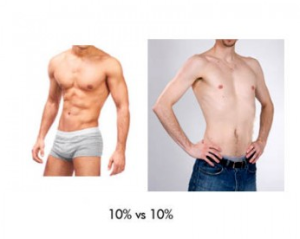
This doesn’t guarantee future type 2 for this body build, but it’s a risk factor. Who needs a risk factor for this disease?
“There is a general recommendation from the American Heart Association for a minimum of 150 minutes of exercise per week,” says Dr. Patel.
“This should be moderate or higher intensity and should get your heart going.
“Diet has also been compared between races living in different nations.
“A Western diet that is not controlled and contains high amounts of processed foods, sugars and fat can lead to type 2 diabetes.
“Overall research has shown genetic involvement is present but not huge, so I would focus on diet in a specific person as well as exercise per AHA guidelines — not for weight loss but for overall well-being from a cardiovascular and insulin standpoint.
“It appears aside from weight the same levels of inactivity and poor oral intake contribute the most towards the diagnosis.
“What else matters? Your lifestyle does! Excessive alcohol consumption, poor sleep, poor stress management and illegal substance abuse can contribute to insulin resistance.”

